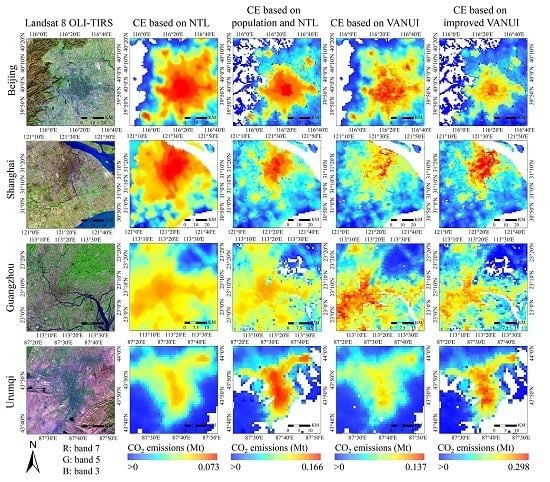An Improved Vegetation Adjusted Nighttime Light Urban Index and Its Application in Quantifying Spatiotemporal Dynamics of Carbon Emissions in China
Abstract
:1. Introduction
2. Study Area and Data Description
2.1. Study Area
2.2. Data Description
3. Methods
3.1. An Improved Time-Series VANUI
3.2. Estimating CO2 Emissions Using Improved VANUI
3.3. Assessing the Accuracy of Improved VANUI in Modeling CO2 Emissions
3.4. Analyzing Spatiotemporal Patterns of Prefecture-City Level CO2 Emissions
4. Results
4.1. Performance Test of the Improved VANUI
4.2. Accuracy Assessment of Improved VANUI in Modeling CO2 Emissions
4.3. Spatiotemporal Dynamics CO2 Emissions in China
5. Discussion
5.1. Comparison with Previous Studies
5.2. Limitations and Potential Uses
6. Conclusions
Acknowledgments
Author Contributions
Conflicts of Interest
References
- Doll, C.N.H.; Muller, J.P.; Morley, J.G. Mapping regional economic activity from night-time light satellite imagery. Ecol. Econ. 2006, 57, 75–92. [Google Scholar] [CrossRef]
- Henderson, J.V.; Storeygard, A.; Weil, D.N. Measuring economic growth from outer space. Am. Econ. Rev. 2012, 102, 994–1028. [Google Scholar] [CrossRef] [PubMed]
- Ma, T.; Zhou, C.H.; Pei, T.; Haynie, S.; Fan, J.F. Quantitative estimation of urbanization dynamics using time series of DMSP/OLS nighttime light data: A comparative case study from China’s cities. Remote Sens. Environ. 2012, 124, 99–107. [Google Scholar] [CrossRef]
- Gao, B.; Huang, Q.; He, C.; Ma, Q. Dynamics of urbanization levels in China from 1992 to 2012: Perspective from DMSP/OLS nighttime light data. Remote Sens. 2015, 7, 1721–1735. [Google Scholar] [CrossRef]
- Ma, T.; Zhou, Y.; Zhou, C.; Haynie, S.; Pei, T.; Xu, T. Night-time light derived estimation of spatio-temporal characteristics of urbanization dynamics using DMSP/OLS satellite data. Remote Sens. Environ. 2015, 158, 453–464. [Google Scholar] [CrossRef]
- Elvidge, C.D.; Sutton, P.C.; Ghosh, T.; Tuttle, B.T.; Baugh, K.E.; Bhaduri, B.; Bright, E. A global poverty map derived from satellite data. Comput. Geosci. 2009, 35, 1652–1660. [Google Scholar] [CrossRef]
- Wang, W.; Cheng, H.; Zhang, L. Poverty assessment using DMSP/OLS night-time light satellite imagery at a provincial scale in China. Adv. Space Res. 2012, 49, 1253–1264. [Google Scholar] [CrossRef]
- Jean, N.; Burke, M.; Xie, M.; Davis, W.M.; Lobell, D.B.; Ermon, S. Combining satellite imagery and machine learning to predict poverty. Science 2016, 353, 790–794. [Google Scholar] [CrossRef] [PubMed]
- Letu, H.; Hara, M.; Yagi, H.; Naoki, K.; Tana, G.; Nishio, F.; Shuhei, O. Estimating energy consumption from night-time DMSP/OLS imagery after correcting for saturation effects. Int J. Remote Sens. 2010, 31, 4443–4458. [Google Scholar] [CrossRef]
- Doll, C.N.H.; Muller, J.P.; Elvidge, C.D. Night-time imagery as a tool for global mapping of socioeconomic parameters and greenhouse gas emissions. AMBIO 2000, 29, 157–162. [Google Scholar] [CrossRef]
- Raupach, M.R.; Rayner, P.J.; Paget, M. Regional variations in spatial structure of nightlights, population density and fossil-fuel CO2 emissions. Energy Policy 2010, 38, 4756–4764. [Google Scholar] [CrossRef]
- Sutton, P.C. An empirical environmental sustainability index derived solely from nighttime satellite imagery and ecosystem service valuation. Pop. Environ. 2003, 24, 293–311. [Google Scholar] [CrossRef]
- Elvidge, C.D.; Baugh, K.E.; Dietz, J.B.; Bland, T.; Sutton, P.C.; Kroehl, H.W. Radiance calibration of DMSP-OLS low-light imaging data of human settlements. Remote Sens. Environ. 1999, 68, 77–88. [Google Scholar] [CrossRef]
- Meng, L.; Graus, W.; Worrell, E.; Huang, B. Estimating CO2 (carbon dioxide) emissions at urban scales by DMSP/OLS (defense meteorological satellite program’s operational linescan system) nighttime light imagery: Methodological challenges and a case study for China. Energy 2014, 71, 468–478. [Google Scholar] [CrossRef]
- Lu, H.L.; Liu, G.F. Spatial effects of carbon dioxide emissions from residential energy consumption: A county-level study using enhanced nocturnal lighting. Appl. Energy 2014, 131, 297–306. [Google Scholar] [CrossRef]
- Elvidge, C.D.; Cinzano, P.; Pettit, D.R.; Arvesen, J.; Sutton, P.; Small, C.; Nemani, R.; Longcore, T.; Rich, C.; Safran, J.; et al. The nightsat mission concept. Int. J. Remote Sens. 2007, 28, 2645–2670. [Google Scholar] [CrossRef]
- He, C.Y.; Ma, Q.; Li, T.; Yang, Y.; Liu, Z.F. Spatiotemporal dynamics of electric power consumption in Chinese mainland from 1995 to 2008 modeled using DMSP/OLS stable nighttime lights data. J. Geogr. Sci. 2012, 22, 125–136. [Google Scholar] [CrossRef]
- Cao, X.; Wang, J.; Chen, J.; Shi, F. Spatialization of electricity consumption of China using saturation-corrected DMSP-OLS data. Int. J. Appl. Earth Obs. Geoinf. 2014, 28, 193–200. [Google Scholar] [CrossRef]
- Ghosh, T.; Elvidge, C.D.; Sutton, P.C.; Baugh, K.E.; Ziskin, D.; Tuttle, B.T. Creating a global grid of distributed fossil fuel CO2 emissions from nighttime satellite imagery. Energies 2010, 3, 1895–1913. [Google Scholar] [CrossRef]
- He, C.Y.; Ma, Q.; Liu, Z.F.; Zhang, Q.F. Modeling the spatiotemporal dynamics of electric power consumption in mainland China using saturation-corrected DMSP/OLS nighttime stable light data. Int. J. Digit. Earth 2014, 7, 993–1014. [Google Scholar] [CrossRef]
- Lin, J.Y.; Liu, X.P.; Li, K.; Li, X. A maximum entropy method to extract urban land by combining modis reflectance, modis ndvi, and DMSP-OLS data. Int. J. Remote Sens. 2014, 35, 6708–6727. [Google Scholar] [CrossRef]
- Ma, X.L.; Tong, X.H.; Liu, S.C.; Luo, X.; Xie, H.; Li, C.M. Optimized sample selection in SVM classification by combining with DMSP-OLS, landsat NDVI and globeland 30 products for extracting urban built-up areas. Remote Sens. 2017, 9. [Google Scholar] [CrossRef]
- Zhang, Q.; Schaaf, C.; Seto, K.C. The vegetation adjusted NTL urban index: A new approach to reduce saturation and increase variation in nighttime luminosity. Remote Sens. Environ. 2013, 129, 32–41. [Google Scholar] [CrossRef]
- Ma, Q.; He, C.; Wu, J.; Liu, Z.; Zhang, Q.; Sun, Z. Quantifying spatiotemporal patterns of urban impervious surfaces in China: An improved assessment using nighttime light data. Landsc. Urban Plan. 2014, 130, 36–49. [Google Scholar] [CrossRef]
- Ma, L.; Wu, J.; Li, W.; Peng, J.; Liu, H. Evaluating saturation correction methods for DMSP/OLS nighttime light data: A case study from China’s cities. Remote Sens. 2014, 6, 9853–9872. [Google Scholar] [CrossRef] [Green Version]
- Intergovernmental Panel on Climate Change (IPCC). Climate Change 2007: Synthesis Report. Contribution of Working Groups I, II and III to the Fourth Assessment Report of the Intergovernmental Panel on Climate Change. Available online: http://www.ipcc.ch/publications_and_data/publications_ipcc_fourth_assessment_report_synthesis_report.htm (accessed on 4 July 2017).
- Hirano, Y.; Yoshida, Y. Assessing the effects of CO2 reduction strategies on heat islands in urban areas. Sustain. Cities Soc. 2016, 26, 383–392. [Google Scholar] [CrossRef]
- Coutts, A.; Beringer, J.; Tapper, N. Changing urban climate and CO2 emissions: Implications for the development of policies for sustainable cities. Urban Policy Res. 2010, 28, 27–47. [Google Scholar] [CrossRef]
- Parshall, L.; Gurney, K.; Hammer, S.A.; Mendoza, D.; Zhou, Y.; Geethakumar, S. Modeling energy consumption and CO2 emissions at the urban scale: Methodological challenges and insights from the united states. Energy Policy 2010, 38, 4765–4782. [Google Scholar] [CrossRef]
- Zhou, Y.; Gurney, K.R. Spatial relationships of sector-specific fossil fuel CO2 emissions in the united states. Glob. Biogeochem. Cycles 2011, 25, 1–13. [Google Scholar] [CrossRef]
- Gurney, K.R.; Romero-Lankao, P.; Seto, K.C.; Hutyra, L.R.; Duren, R.; Kennedy, C.; Grimm, N.B.; Ehleringer, J.R.; Marcotullio, P.; Hughes, S.; et al. Climate change: Track urban emissions on a human scale. Nature 2015, 525, 179–181. [Google Scholar] [CrossRef] [PubMed]
- Gregg, J.S.; Andres, R.J.; Marland, G. China: Emissions pattern of the world leader in CO2 emissions from fossil fuel consumption and cement production. Geophys. Res. Lett. 2008, 35. [Google Scholar] [CrossRef]
- NDRC. Energy Production and Consumption Revolution Strategy. Available online: http://www.ndrc.gov.cn/zcfb/zcfbtz/201704/t20170425_845284.html (accessed on 4 May 2017). (In Chinese)
- Liu, Z.; Guan, D.B.; Moore, S.; Lee, H.; Su, J.; Zhang, Q. Steps to China’s carbon peak. Nature 2015, 522, 279–281. [Google Scholar] [CrossRef] [PubMed]
- Wang, S.; Fang, C.; Wang, Y. Spatiotemporal variations of energy-related CO2 emissions in China and its influencing factors: An empirical analysis based on provincial panel data. Renew. Sustain. Energy Rev. 2016, 55, 505–515. [Google Scholar] [CrossRef]
- Hao, Y.; Chen, H.; Wei, Y.-M.; Li, Y.-M. The influence of climate change on CO2 (carbon dioxide) emissions: An empirical estimation based on Chinese provincial panel data. J. Clean. Prod. 2016, 131, 667–677. [Google Scholar] [CrossRef]
- Shi, K.; Chen, Y.; Yu, B.; Xu, T.; Chen, Z.; Liu, R.; Li, L.; Wu, J. Modeling spatiotemporal CO2 (carbon dioxide) emission dynamics in China from DMSP-OLS nighttime stable light data using panel data analysis. Appl. Energy 2016, 168, 523–533. [Google Scholar] [CrossRef]
- National Bureau of Statistics of China. China Energy Statistical Yearbook; China Statistics Press: Beijing, China, 1996–2014.
- Bai, Z.; Wang, C.; Yang, F. Research progress in spatialization of population data. Prog. Geogr. 2013, 32, 1692–1702. (In Chinese) [Google Scholar]
- Liu, Z.; He, C.; Zhang, Q.; Huang, Q.; Yang, Y. Extracting the dynamics of urban expansion in China using DMSP/OLS nighttime light data from 1992 to 2008. Landsc. Urban Plan. 2012, 106, 62–72. [Google Scholar] [CrossRef]
- Doll, C.N.H.; Pachauri, S. Estimating rural populations without access to electricity in developing countries through night-time light satellite imagery. Energy Policy 2010, 38, 5661–5670. [Google Scholar] [CrossRef]
- Steven, M.D.; Malthus, T.J.; Baret, F.; Xu, H.; Chopping, M.J. Intercalibration of vegetation indices from different sensor systems. Remote Sens. Environ. 2003, 88, 412–422. [Google Scholar] [CrossRef]
- Shi, K.; Chen, Y.; Yu, B.; Xu, T.; Li, L.; Huang, C.; Liu, R.; Chen, Z.; Wu, J. Urban expansion and agricultural land loss in China: A multiscale perspective. Sustainability 2016, 8, 790. [Google Scholar] [CrossRef]
- Zhuo, L.; Ichinose, T.; Zheng, J.; Chen, J.; Shi, P.J.; Li, X. Modelling the population density of China at the pixel level based on DMSP/OLS non-radiance-calibrated night-time light images. Int. J. Remote Sens. 2009, 30, 1003–1018. [Google Scholar] [CrossRef]
- Intergovernmental Panel on Climate Change (IPCC). IPCC Guidelines for National Greenhouse Gas Inventories. Available online: http://www.ipcc-nggip.iges.or.jp/public/2006gl/ (accessed on 30 December 2016).
- National Development and Reform Commission (NDRC). Baseline Emission Factors for Regional Power Grids in China. Available online: http://qhs.ndrc.gov.cn/ (accessed on 2 January 2017). (In Chinese)
- National Development and Reform Commission (NDRC). The People’s Republic of China National Greenhouse Gas Inventory; China Environmental Science Press: Beijing, China, 2014.
- Anselin, L. Local indicators of spatial association (LISA). Geogr. Anal. 1995, 27, 93–115. [Google Scholar] [CrossRef]
- Rey, S.J. Spatial empirics for economic growth and convergence. Geogr. Anal. 2001, 33, 195–214. [Google Scholar] [CrossRef]
- Su, Y.; Chen, X.; Li, Y.; Liao, J.; Ye, Y.; Zhang, H.; Huang, N.; Kuang, Y. China’s 19-year city-level carbon emissions of energy consumptions, driving forces and regionalized mitigation guidelines. Renew. Sustain. Energy Rev. 2014, 35, 231–243. [Google Scholar] [CrossRef]
- Worldwatch Institute. Renewable Energy and Energy Efficiency in China: Current Status and Prospects for 2020. Available online: http://www.worldwatch.org/bookstore/publication/worldwatch-report-182-renewable-energy-and-energy-efficiency-china-current-sta (accessed on 22 July 2017).
- Wang, H.; Zhang, R.; Liu, M.; Bi, J. The carbon emissions of Chinese cities. Atmos. Chem. Phys. 2012, 12, 6197–6206. [Google Scholar] [CrossRef]
- Yu, W.; Pagani, R.; Huang, L. CO2 emission inventories for Chinese cities in highly urbanized areas compared with european cities. Energy Policy 2012, 47, 298–308. [Google Scholar] [CrossRef]
- Mi, Z.; Zhang, Y.; Guan, D.; Shan, Y.; Liu, Z.; Cong, R.; Yuan, X.-C.; Wei, Y.-M. Consumption-based emission accounting for Chinese cities. Appl. Energy 2016, 184, 1073–1081. [Google Scholar] [CrossRef]
- Feng, K.S.; Hubacek, K.; Sun, L.X.; Liu, Z. Consumption-based CO2 accounting of China’s megacities: The case of beijing, tianjin, shanghai and chongqing. Ecol. Indic. 2014, 47, 26–31. [Google Scholar] [CrossRef]
- Li, B.; Liu, X.J.; Li, Z.H. Using the stirpat model to explore the factors driving regional CO2 emissions: A case of Tianjin, China. Nat. Hazards 2015, 76, 1667–1685. [Google Scholar] [CrossRef]
- Andres, R.J.; Boden, T.A.; Breon, F.M.; Ciais, P.; Davis, S.; Erickson, D.; Gregg, J.S.; Jacobson, A.; Marland, G.; Miller, J.; et al. A synthesis of carbon dioxide emissions from fossil-fuel combustion. Biogeosciences 2012, 9, 1845–1871. [Google Scholar] [CrossRef] [Green Version]
- Liu, Z.; Guan, D.; Wei, W.; Davis, S.J.; Ciais, P.; Bai, J.; Peng, S.; Zhang, Q.; Hubacek, K.; Marland, G.; et al. Reduced carbon emission estimates from fossil fuel combustion and cement production in China. Nature 2015, 524, 335–338. [Google Scholar] [CrossRef] [PubMed]
- Guan, D.; Liu, Z.; Geng, Y.; Lindner, S.; Hubacek, K. The gigatonne gap in China’s carbon dioxide inventories. Nat. Clim. Chang. 2012, 2, 672–675. [Google Scholar] [CrossRef]
- Han, J.; Meng, X.; Zhou, X.; Yi, B.L.; Liu, M.; Xiang, W.N. A long-term analysis of urbanization process, landscape change, and carbon sources and sinks: A case study in China’s yangtze river delta region. J. Clean. Prod. 2017, 141, 1040–1050. [Google Scholar] [CrossRef]
- Marcotullio, P.J.; Sarzynski, A.; Albrecht, J.; Schulz, N. The geography of urban greenhouse gas emissions in Asia: A regional analysis. Glob. Environ. Chang. 2012, 22, 944–958. [Google Scholar] [CrossRef]
- Sharma, S.S. Determinants of carbon dioxide emissions: Empirical evidence from 69 countries. Appl. Energy 2011, 88, 376–382. [Google Scholar] [CrossRef]
- Dobson, J.E.; Bright, E.A.; Coleman, P.R.; Durfee, R.C.; Worley, B.A. Landscan: A global population database for estimating populations at risk. Photogramm. Eng. Remote Sens. 2000, 66, 849–857. [Google Scholar]
- National Geomatics Center of China (NGCC), Global Land Cover Mapping at 30 m Resolution. Available online: http://ngcc.sbsm.gov.cn/article/en/ps/mp/201302/20130200001694.shtml (accessed on 24 July 2017).

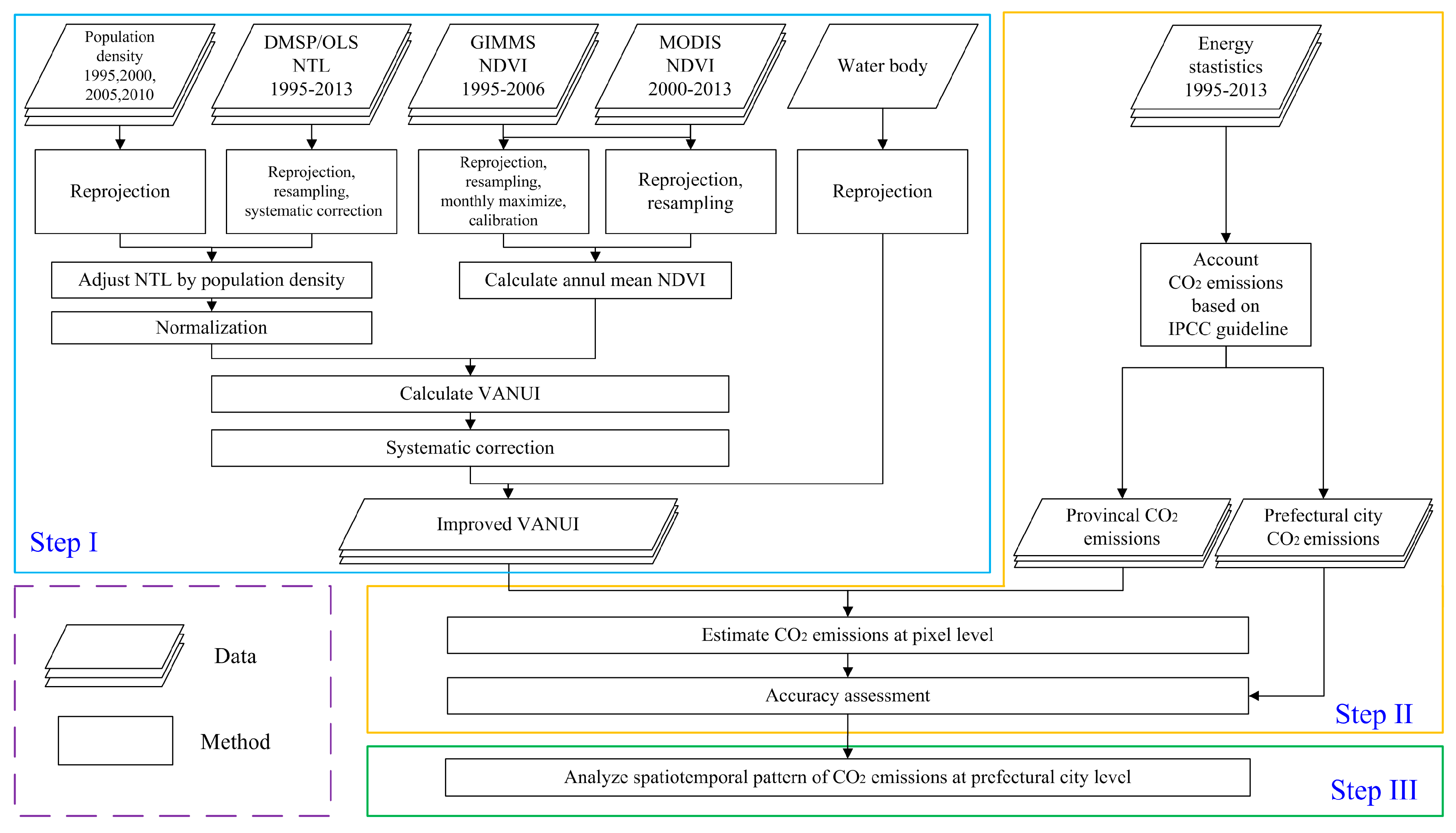
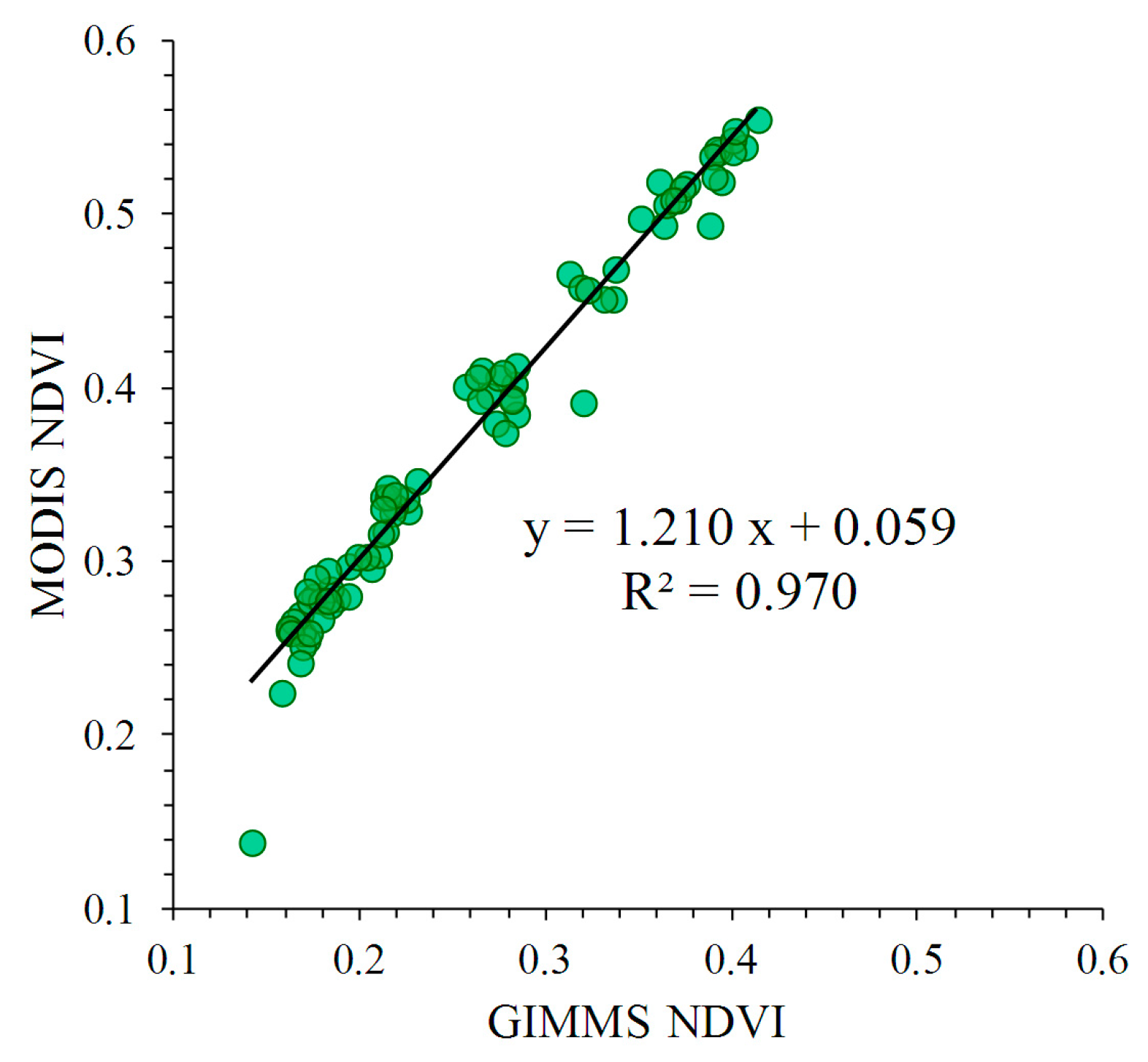

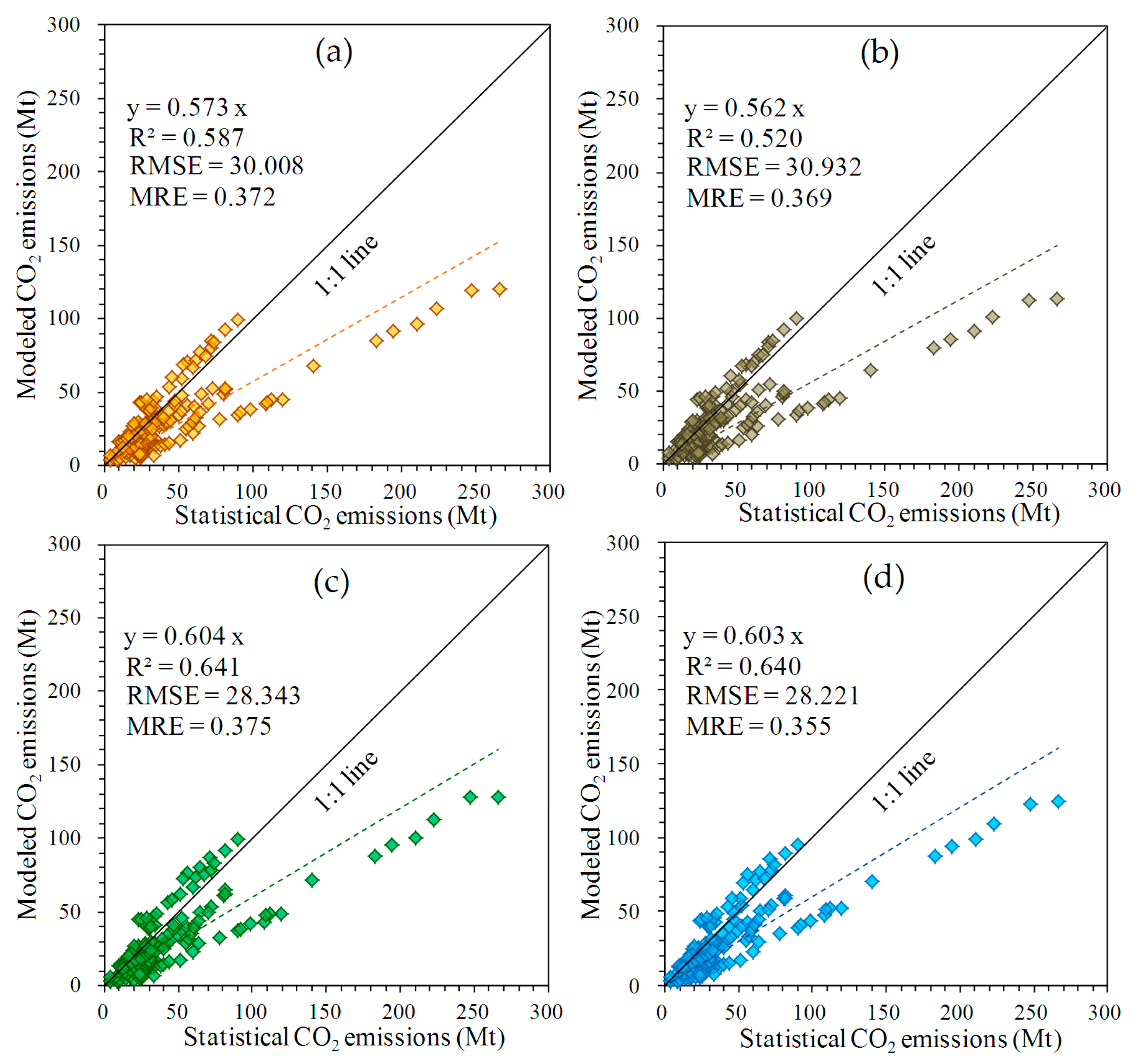

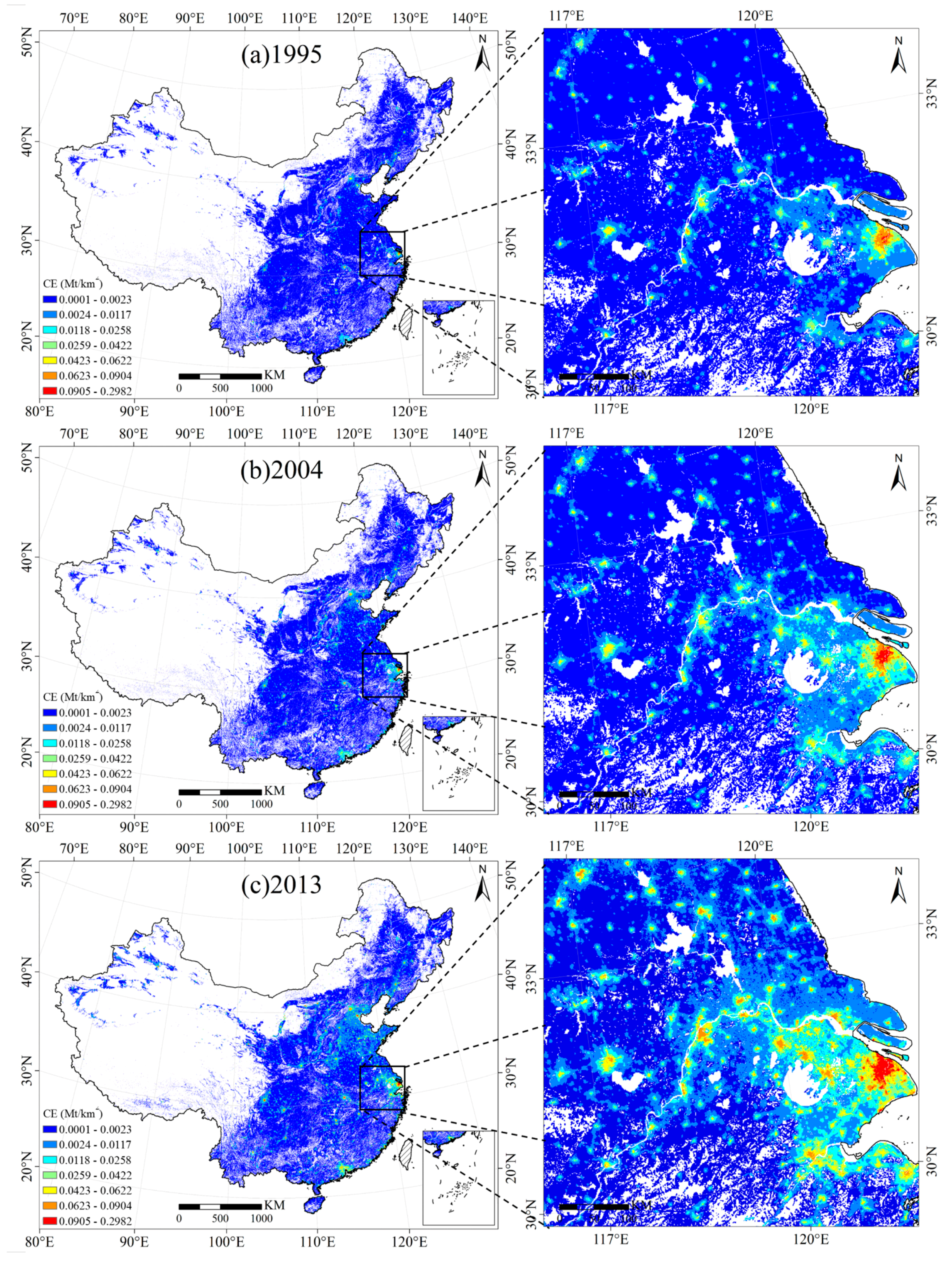
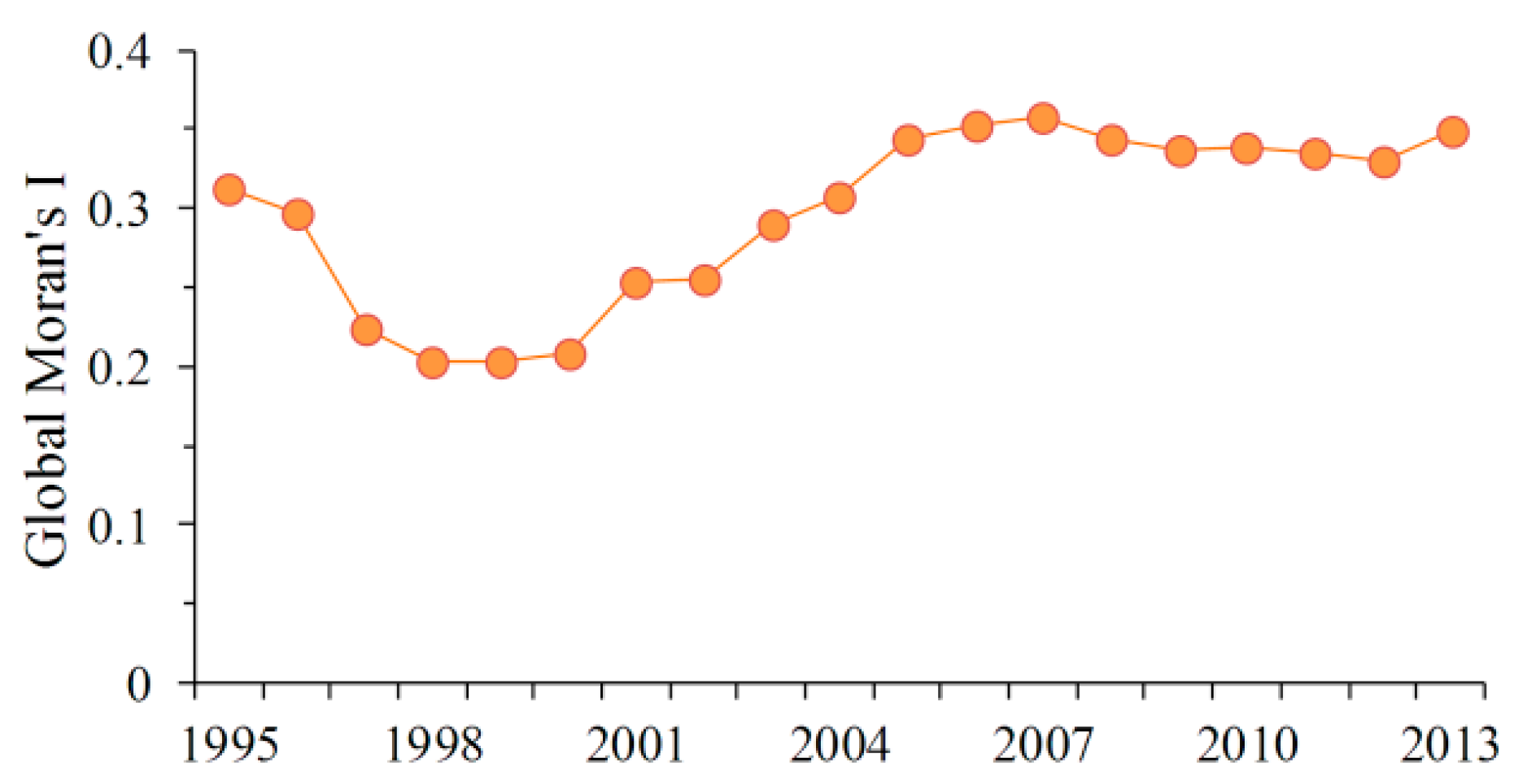

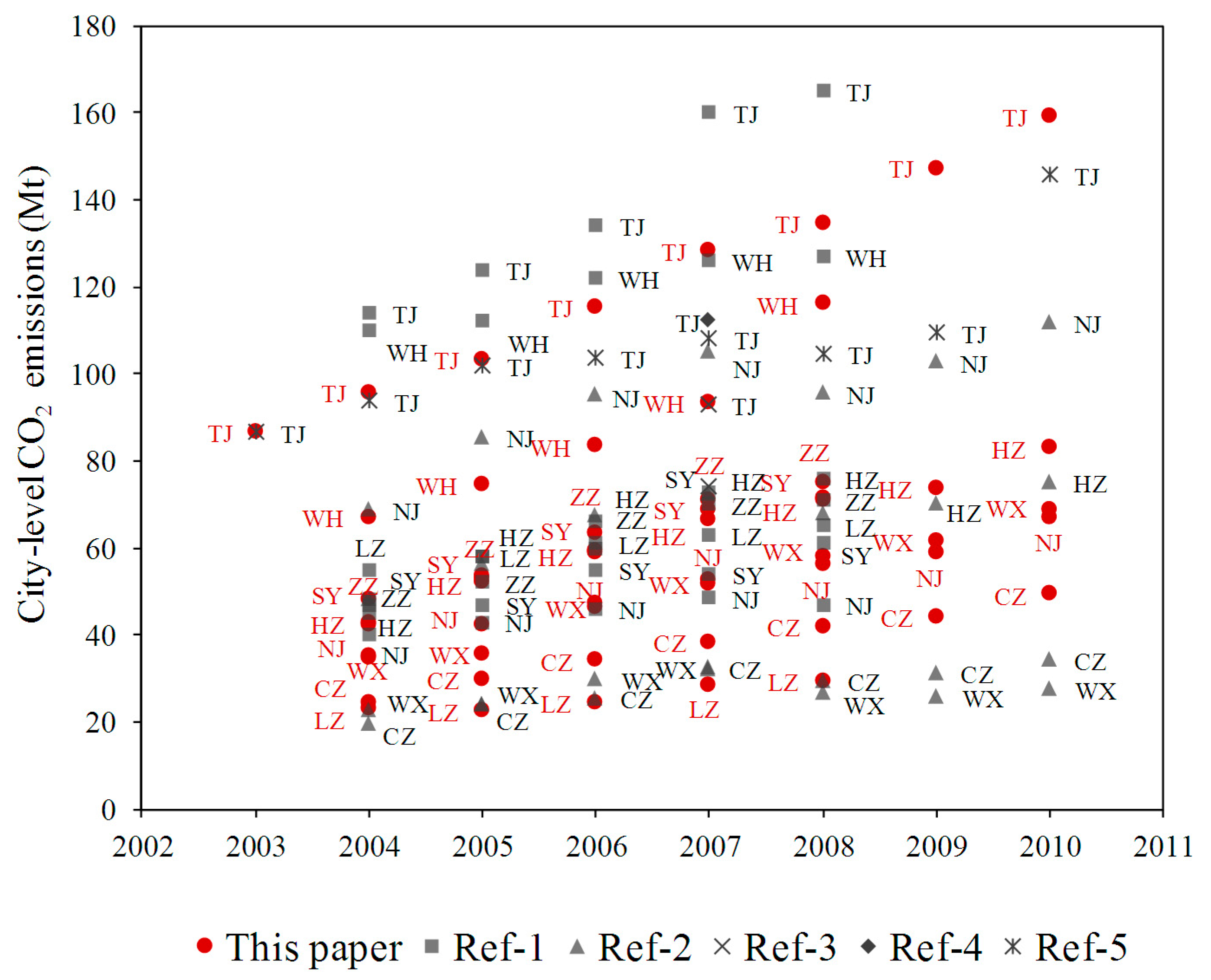
| City | Administrative Area (km2) | Population (Million) | Population Density (Persons/km2) | Gross Domestic Product (Billion RMB) |
|---|---|---|---|---|
| Changde | 18,176 | 5.80 | 319 | 2264.94 |
| Changsha | 11,816 | 7.22 | 611 | 7153.13 |
| Chenzhou | 19,342 | 4.67 | 241 | 1685.52 |
| Guangzhou | 7436 | 8.32 | 1119 | 15,420.14 |
| Hechi | 33,494 | 3.43 | 102 | 528.62 |
| Hengyang | 15,300 | 7.25 | 474 | 2169.44 |
| Hohhot | 17,344 | 3.00 | 173 | 2705.39 |
| Huaihua | 27,573 | 4.83 | 175 | 1117.67 |
| Jinan | 8177 | 7.00 | 856 | 5230.19 |
| Jincheng | 9425 | 2.30 | 244 | 1028.05 |
| Jingzhou | 14,104 | 5.74 | 407 | 1334.93 |
| Laibin | 13,386 | 2.15 | 161 | 515.57 |
| Loudi | 8110 | 3.83 | 473 | 1118.17 |
| Luoyang | 15,492 | 6.62 | 427 | 3140.76 |
| Qiqihar | 44,287 | 5.57 | 126 | 1230.40 |
| Quzhou | 8837 | 2.54 | 288 | 1056.57 |
| Shaoyang | 20,822 | 7.20 | 346 | 1130.04 |
| Shenyang | 12,980 | 7.27 | 560 | 7158.57 |
| Tangshan | 13,829 | 7.71 | 557 | 6121.21 |
| Weifang | 16,138 | 9.23 | 572 | 4420.70 |
| Xiangtan | 5005 | 2.80 | 559 | 1443.06 |
| Xiangxi | 15,470 | 2.60 | 168 | 418.94 |
| Xinyu | 3178 | 1.16 | 364 | 845.07 |
| Yichang | 21,081 | 4.10 | 194 | 2818.07 |
| Yiyang | 12,320 | 4.37 | 355 | 1123.13 |
| Yongzhou | 22,259 | 5.33 | 239 | 1175.45 |
| Yueyang | 14,858 | 5.56 | 374 | 2435.51 |
| Zhangjiajie | 9534 | 1.51 | 159 | 365.65 |
| Zhangjiakou | 36,303 | 4.41 | 122 | 1317.02 |
| Zhuzhou | 11,248 | 3.93 | 350 | 1949.43 |
| Category | Data | Description | Year | Data Source |
|---|---|---|---|---|
| Statistical data | Energy consumption | Annual consumption of raw coal, clean coal, coke, coke oven gas, crude oil, gasoline, kerosene, diesel oil, fuel oil, liquefied petroleum gases, natural gas, heat and electricity for 30 provinces and 30 prefectural-level cities | 1995–2013 | China Statistical Yearbooks Database (http://tongji.cnki.net/overseas/engnavi/navidefault.aspx) |
| Geospatial data | DMSP/OLS | Annual composite nighttime stable light data with 30 arc second grids | 1995–2013 | National Oceanic and Atmospheric Administration’s National Centers for Environmental Information (former National Geophysical Data Center) (https://ngdc.noaa.gov/eog/dmsp/downloadV4composites.html) |
| GIMMS NDVI | GIMMS 15-day composite NDVI data of China at 8-km resolution | 1995–2006 | Environmental and Ecological Science Data Center for West China (http://westdc.westgis.ac.cn/) | |
| MODIS NDVI | MODIS monthly composite NDVI data of China with 1-km resolution | 2000–2013 | International Scientific & Technical Data Mirror Site, Computer Network Information Center (http://www.gscloud.cn) | |
| Population density | Population density per 1 km of China | 1995, 2000, 2005, and 2010 | Resources and Environmental Sciences Data Center (http://www.resdc.cn) | |
| Water-masked map | A shapefile of water bodies in China | 2013 | ESRI Baruch Geoportal (https://www.baruch.cuny.edu/confluence/display/geoportal/Datasets) | |
| Administrative boundaries | Shapefiles of province and prefectural-level cities in China | 2012 | Resources and Environmental Sciences Data Center (http://www.resdc.cn) | |
| Landsat 8 OLI-TIRS | Four images covering Beijing, Shanghai, Guangzhou and Urumqi at 30-m resolution | 2013 | International Scientific & Technical Data Mirror Site, Computer Network Information Center (http://www.gscloud.cn) |
| Energy Type (k) | Low Calorific Value (LC, kJ/kg; kJ/m3) | Carbon Content (CC, kg/GJ) | Carbon Oxidation Factor (CR, %) | CO2 Emission Factor (EF, t/t; t/104 m3) |
|---|---|---|---|---|
| Raw coal | 20,908 | 26.37 | 94% | 1.90 |
| Clean coal | 26,344 | 27.40 | 94% | 2.49 |
| Coke | 28,435 | 29.50 | 93% | 2.86 |
| Coke oven gas | 16,726 | 12.10 | 98% | 0.73 |
| Crude oil | 41,816 | 20.10 | 98% | 3.02 |
| Gasoline | 43,070 | 18.90 | 98% | 2.93 |
| Kerosene | 43,070 | 19.60 | 98% | 3.03 |
| Diesel oil | 42,652 | 20.20 | 98% | 3.10 |
| Fuel oil | 41,816 | 21.10 | 98% | 3.17 |
| Liquefied petroleum gases | 50,179 | 17.20 | 99% | 3.13 |
| Natural gas | 38,931 | 15.30 | 99% | 2.16 |
| Heat | \ | \ | \ | 0.12 (t/GJ) |
| Electricity | \ | \ | \ | 1.01 (t/MWh) |
| Year | T-Value of | T-Value of | R2 | ||
|---|---|---|---|---|---|
| 1995 | 39.3528 ** | 4.4998 | 0.0612 ** | 8.9893 | 0.7566 |
| 1996 | 42.2589 ** | 4.9570 | 0.0599 ** | 9.1793 | 0.7642 |
| 1997 | 45.2605 ** | 5.4585 | 0.0590 ** | 9.2259 | 0.7525 |
| 1998 | 44.2361 ** | 5.3296 | 0.0602 ** | 9.5906 | 0.7666 |
| 1999 | 43.9072 ** | 5.3252 | 0.0603 ** | 9.9401 | 0.7792 |
| 2000 | 44.9229 ** | 5.1266 | 0.0635 ** | 10.1248 | 0.7855 |
| 2001 | 40.2911 ** | 4.8998 | 0.0700 ** | 12.8600 | 0.8552 |
| 2002 | 46.8830 ** | 5.1477 | 0.0680 ** | 11.8764 | 0.8344 |
| 2003 | 48.9646 ** | 4.5677 | 0.0718 ** | 11.6740 | 0.8296 |
| 2004 | 51.8829 ** | 4.4405 | 0.0790 ** | 12.6101 | 0.8503 |
| 2005 | 39.9260 ** | 2.8469 | 0.0989 ** | 14.1337 | 0.8771 |
| 2006 | 43.8580 ** | 2.8240 | 0.1061 ** | 14.3041 | 0.8796 |
| 2007 | 45.4787 * | 2.5905 | 0.1176 ** | 14.2543 | 0.8789 |
| 2008 | 48.8460 * | 2.4972 | 0.1225 ** | 13.6811 | 0.8699 |
| 2009 | 55.0179 * | 2.4996 | 0.1259 ** | 12.7556 | 0.8532 |
| 2010 | 50.0169 * | 2.1165 | 0.1353 ** | 12.5029 | 0.8481 |
| 2011 | 55.1558 * | 2.0569 | 0.1431 ** | 12.3903 | 0.8457 |
| 2012 | 55.8876 * | 2.1275 | 0.1402 ** | 12.7299 | 0.8527 |
| 2013 | 65.4914 * | 2.3874 | 0.1333 ** | 11.5752 | 0.8271 |
© 2017 by the authors. Licensee MDPI, Basel, Switzerland. This article is an open access article distributed under the terms and conditions of the Creative Commons Attribution (CC BY) license (http://creativecommons.org/licenses/by/4.0/).
Share and Cite
Meng, X.; Han, J.; Huang, C. An Improved Vegetation Adjusted Nighttime Light Urban Index and Its Application in Quantifying Spatiotemporal Dynamics of Carbon Emissions in China. Remote Sens. 2017, 9, 829. https://doi.org/10.3390/rs9080829
Meng X, Han J, Huang C. An Improved Vegetation Adjusted Nighttime Light Urban Index and Its Application in Quantifying Spatiotemporal Dynamics of Carbon Emissions in China. Remote Sensing. 2017; 9(8):829. https://doi.org/10.3390/rs9080829
Chicago/Turabian StyleMeng, Xing, Ji Han, and Cheng Huang. 2017. "An Improved Vegetation Adjusted Nighttime Light Urban Index and Its Application in Quantifying Spatiotemporal Dynamics of Carbon Emissions in China" Remote Sensing 9, no. 8: 829. https://doi.org/10.3390/rs9080829




